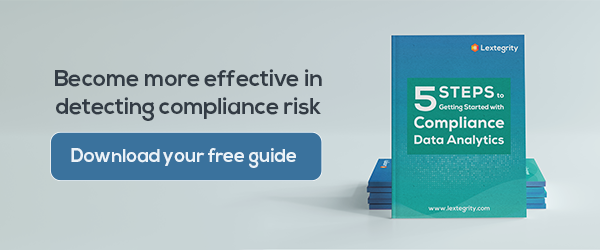Combating corruption and fraud is a constant challenge and financial drain for organizations. Compliance professionals face increasingly sophisticated fraud schemes, and traditional compliance tools, such as periodic and sample-based audits and hotline reports, are unable to keep pace with bad actors. Furthermore, regulators worldwide have begun to enforce their anti-corruption laws with increasing aggressiveness, which has made having effective corporate compliance programs a top priority for organizations of all sizes in recent years.
Modern compliance management software is one of the most effective options that organizations can leverage to get ahead in the fight against corruption and fraud and remain in good standing with regulators. Corporate compliance software that is bolstered by data analytics is capable of organizing and risk scoring data across an organization faster and more accurately than traditional methods of risk management, which enables compliance professionals to focus on the high-value tasks that require review and risk analysis.
Though compliance software has become an increasingly popular tool for organizations that seek to proactively combat fraud and corruption, there are still a handful of misconceptions about the importance and application of risk and compliance software. With that in mind, let’s break down some of the common expectations that compliance officers and internal auditors have about compliance software by examining how the technology works in reality.
Expectation: Compliance software will replace the need for organizations to employ compliance professionals
Reality: Compliance software can streamline many compliance processes, but it’s not the kind of technology that is intended to replace compliance professionals or internal auditors. Instead, compliance software should be viewed as a set of tools that can automate the tedious manual processes to which compliance professionals typically have to devote inordinate amounts of their time. For example, internal audit teams frequently spend significant amounts of time cleaning and organizing data sets, rather than analyzing said data to determine if fraud is taking place in their organization.
Effective compliance software is capable of supporting the completion of, or entirely automating, such time-consuming tasks, which allows compliance professionals to focus more of their time on high-value activities, such as interpreting the data provided by the software.
While compliance software is an invaluable tool for automating specific parts of an organization’s compliance processes, it will never be a replacement for individuals with specialized skill sets. Compliance professionals understand their industry and their organization’s policies, procedures, and risks and will always play an integral role in using data to make more informed decisions. For example, a transaction flagged by compliance software as an anomaly will require a risk professional to assess whether the transaction is, in fact, fraudulent or corrupt.
Expectation: Compliance software might be efficient, but it isn’t thorough enough to flag most potential problems
Reality: Compliance software can be a significant time saver for organizations, but that doesn’t mean that it sacrifices details or accuracy for the sake of convenience. Compliance software is capable of providing compliance professionals with superior data sets compared to traditional methods of data gathering.
Legacy approaches to compliance center on sample-based audits, subjective risk assessments, and self-selected hotline reports, none of which provide thoroughly detailed and unbiased information about an organization’s spend. On the other hand, an effective corporate compliance system will be able to gather all data from enterprise systems, including enterprise resource planning, travel and expense, and human resources systems, and automatically risk score the data and then flag anomalous findings for manual review.
This unified data allows organizations to root out suspicious transactions and other forms of potential fraud before they become systemic, while traditional tools such as manual audits can take months or even years to locate and flag serious issues.
One particularly noteworthy benefit of using compliance systems is their ability to overcome the limits of third-party due diligence. Traditional methods of determining the level of risk a third party poses generally don’t go beyond basic analyses, such as whether a third party interacts with government officials. In this example, the third party could be erroneously categorized as low risk if the employee performing due diligence was unaware of what those government interactions entail.
Due diligence can also fail to accurately determine risk if employees act in bad faith by providing false information or colluding with the third party to cheat the due diligence process. Organizations can ensure that their third-party partners are consistently acting in good faith by using compliance systems, which can continuously monitor third-party transactions after the onboarding process.
Expectation: Purchasing compliance software will result in the system immediately delivering actionable insights and meeting the goals of the organization
Reality: While compliance software is more efficient for organizations in the long run, it’s essential to understand that implementation comes with a ramp-up period. When considering adding software into an organizational compliance strategy, compliance professionals should consider the following five key points to ensure that that the software will be able to match the goals of their organization:
-
Will the software be able to integrate data from your organization’s various data silos?
-
What kinds of access control options will be available while using the compliance software? For example, will you be able to limit who has access to specific sets of data, such as only allowing managers on an organization’s French compliance team to access transaction data from France?
-
What types of reporting will the software provide? How user-friendly will those reports be? Can the reports that are produced be visualized, such as via dashboarding?
-
What types of groups, such as countries, vendors, third parties, and employees, will the software be able to risk score? How micro-targeted can those risk scores be?
-
Does the software apply machine learning to the data it risk scores to ensure that the system’s analyses deliver more accurate results over time?
Expectation: Compliance software requires advanced technical knowledge to operate
Reality: While it’s true that building compliance software from the ground up is a significant technical undertaking, effective compliance software should be designed to be user-friendly. One of the primary benefits of using compliance software is that it streamlines critical tasks such as data gathering and risk scoring to aid compliance professionals in their work.
Effective risk and compliance software shouldn’t require a specialized skill set in technology or data science; if the software is not intuitive for its users, there is no reason to use it. Standard office tools such as email, word processing, and graphic design have become more user-friendly than ever in recent years. There’s no reason that compliance systems should be any different.
Intuitive compliance software should be capable of compiling siloed data across an organization and automatically presenting that information in an easily readable format for compliance professionals without the need for a data scientist. Compliance software can also visualize the data via dashboarding, which allows compliance professionals to present their findings to their board and C-suite in a visually-engaging style.
Expectation: Buying compliance software is prohibitively expensive
Reality: It’s important for organizations to look beyond the upfront costs when considering purchasing compliance software. Aside from automating time-intensive tasks such as data organization (and therefore allowing compliance professionals to spend their time more efficiently), compliance software provides superior data and risk assessments than traditional compliance tools, which aids organizations in their fight against financial corruption and waste and ultimately makes the software resource-neutral or a cost saver.
Additionally, many organizations traditionally have their data stored in multiple disparate systems, which means that they have to sometimes pay consultants or split their IT team’s resources thinly to access the data. Modern compliance software can pull data from those disconnected systems together in an automated manner, which allows an organization’s compliance and IT teams to focus their resources on using a single, holistic platform for accessing data from their enterprise resource planning, travel and expense and other systems going forward.
Using compliance software might seem unnecessary for organizations that already use manual compliance processes, but given the many aforementioned limits of traditional compliance processes, from due diligence and subjective auditing to manually organizing data sets, the question is whether organizations can afford not to begin utilizing more modern forms of compliance tools.
Proactively uncovering problems with compliance software, rather than waiting for a whistleblower or regulatory investigation, can save an organization significant amounts of money compared to having to deal with an expensive legal case or a public relations disaster.
Conclusion
Data-driven compliance software is a relatively new tool for organizations seeking to modernize their compliance programs. Still, the technology is already utilized by companies such as Alexion and Halliburton. The adoption of compliance software is likely to accelerate in 2022 and beyond, as compliance management software becomes more accessible to businesses of every size. Traditional methods of tracking company spend, such as messy and disjointed spreadsheets of data, and detection tools such as hotline and whistleblower reports that typically offer too little, too late, can be supplemented or entirely replaced by modern compliance management software.
Compliance software enables compliance, audit, and investigation teams to spend less time churning through numbers and more time analyzing neatly organized data that has already been risk scored by the system. This ensures that organizations can be more proactive, efficient and thorough in their fight against fraud and corruption.
If you have additional questions about how compliance software functions or are curious about how compliance software can benefit your organization, reach out to us to learn more.
FAQ
What are the top myths about compliance software?
The top 5 myths about risk and compliance software are:
-
Compliance software replaces the need for compliance professionals
-
Compliance software can't flag most potential problems
-
Compliance software delivers actionable insights immediately
-
Compliance software requires advanced technical knowledge to implement and operate
-
Compliance software is prohibitively expensive
Why do I need compliance software?
Compliance management software can unify compliance systems and provide a holistic view of spend from pre-approval to monitoring. It streamlines processes and saves companies time and money while preventing non-compliance. In addition to the internal benefits, compliance software offers the data analytics that regulators and DOJ regulations require.









